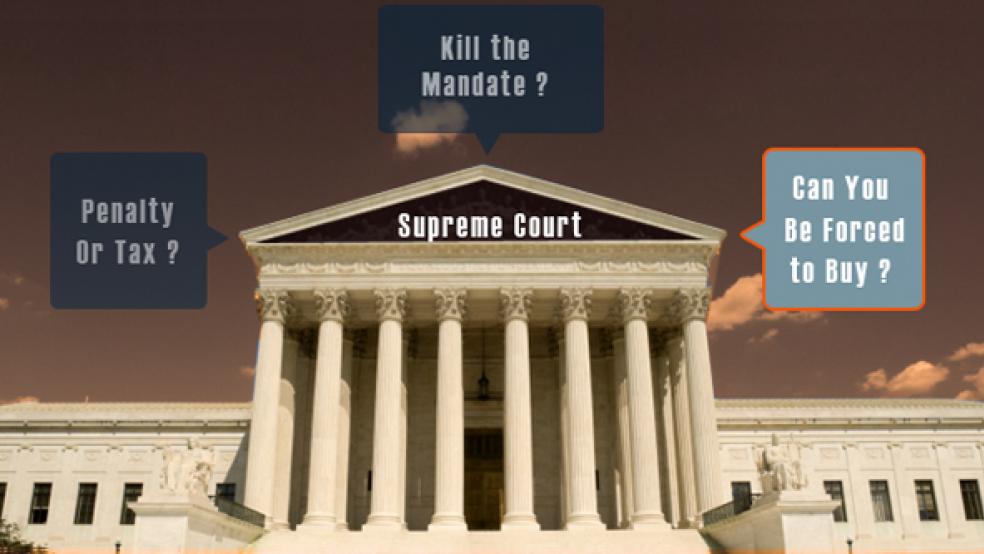Justices on the Supreme Court who are leaning toward striking down President Obama’s signature health care mandate on its constitutionality stared into the abyss on the third and final day of historic oral arguments. If the mandate goes, what else goes with it?
For conservative jurists like Antonin Scalia, who openly sided with plaintiffs seeking to strike down the Affordable Care Act, the answer is simple. Without the mandate, the entire act crumbles and Congress has to start over.
But for most justices, especially the law’s staunchest defenders, the line is murky and deciding which sections of the law cannot be “severed” from an unconstitutional mandate would plunge the court into the messy business of legislating. Congress did not specify which sections of the law depended on the individual mandate, although it did call it “essential” to other insurance reforms like guaranteed issue, where people can’t be denied coverage based on previous health history, and community rating, where premiums cannot be determined by health status.
“Unless Congress tells us directly it is not severable, we should let them fix their own,” said Justice Sonia Sotomayor, an Obama appointee to the high court. “Why in a democracy structured like ours where each branch does different things, why should we involve the court in making a legislative judgment?”
Many economists, including architects of the Massachusetts and federal reform laws, say that failure to include a mandate that consumers buy coverage will encourage millions of healthy people, many of them young, to drop coverage since they would be able under the guaranteed issue rule to buy coverage in an emergency. That would cause rates to skyrocket, causing more people to drop coverage, and lead to a “death spiral” that would destroy the entire market.
The Obama administration essentially agrees with that position and pushed for a bill that satisfied the economic needs of the insurance industry. In arguing there was limited severability for the mandate, Assistant Solicitor General Edwin Kneedler repeatedly told the justices that the legislative language that the mandate was “essential” to the smooth functioning of the act only applied to a limited number of its other insurance regulations.
Yet conservatives on the court focused on the economic impact that a mandate-less reform would have on insurers. Justice Anthony Kennedy said, “It is the proper function of this court to impose that kind of risk. Can we say Congress intended to impose that kind of risk?”
That left it to court-appointed attorney H. Bartow Farr III to make the case that if the mandate was deemed unconstitutional, the rest of the law, including its insurance regulations and expansion, could stand. “Even without the mandate, those two provisions (community rating and guaranteed issue) will do good,” he told the court. “Even though the system wouldn’t work exactly as Congress wanted, it would certainly serve people who were unable to get coverage or get it at affordable prices.”
Farr argued that there were already numerous provisions in the act that would prevent the dreaded insurance death spiral. He pointed to the law’s generous subsidies for people earning less than 200 percent of poverty and the government’s obligation to pick up the tab if premiums rise faster than what is deemed affordable. He also noted that insurers have the right to set up annual enrollment periods. “People can’t just show up at the hospital,” he said.
“Do you want us to write an opinion that there will be an insignificant risk to the insurance companies,” asked an incredulous Kennedy. “It doesn’t sound right the way you say it,” responded Farr. “I agree there is a risk. People can debate the significance of it. What’s lost is on the other side. . . .Would rather go back to the old system than take the risk you’re talking about?”
It’s unlikely that the sections of the law that don’t involve health insurance will fall. While political opponents have repeatedly pointed to the law’s heft as a “federal takeover” of health care, most of its 2,500-plus pages have nothing to do with coverage and will likely remain intact after the high court’s June decision.
They include provisions for reforming Medicare payments; encouraging Accountable Care Organizations; conducting comparative effectiveness research; setting up a regulatory scheme to allow generic biologic drugs to enter the market; and requiring drug and medical device companies to disclose payments to physicians, among others.
“A lot of these provisions were the price of a vote. Put in the black lung provision and I’ll go along with it,” said Chief Justice John Roberts. “That’s why many of these provisions were put in, not because they were objectionable.”
“If you want to keep the periphery, that’s fine,” replied Paul Clement, who argued the case for the 26 states challenging the reform law.
During the afternoon session, the justices turned to the claim by 26 Republican-led states that the Medicaid expansion represented an unconstitutional coercion by the federal government. If states don’t enact the coverage expansions included in the law, their entire Medicaid grants could be at risk.
Liberals on the bench were especially vigorous in attacking the states’ argument. “The usual meaning of coercion is I don’t have a choice,” said Sotomayor. “I don’t see where this would leave the states without a choice. It’s a political choice whether they choose to do that or not.”
Responding to plaintiff arguments that the current Medicaid expansion was unique because of its size and scope, Justice Stephen Breyer pointed out that the Medicaid expansions of the 1980s that covered children had the same impact in terms of cost.
Roberts’ response indicated the Medicaid claim is unlikely to go far. Pointing out that states have taken federal money since the New Deal, “they tied the strings, (so) they (the states) shouldn’t be surprised that the federal government is going to start pulling them,” he said.





